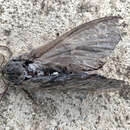en
names in breadcrumbs



Abantiades is a genus of moths of the family Hepialidae. There are 37 described species, all found exclusively in Australia.[2] The group includes some large species with a wingspan of up to 160 mm. The larvae feed on the roots of Eucalyptus and other trees. Simonsen's 2018 revision of the Australian Hepialidae synonymized the genera Bordaia and Trictena to Abantiades, and included the former genera's species here.[2]
The Pindi moth (A. latipennis) is an abundant species of the eucalypt forests of Tasmania and, unlike many invertebrate species, appears to adapt well to the controversial forestry practice of clearfelling.
Abantiades includes the following species:[1]
 Pindi moth (A. latipennis), Tasmania
Pindi moth (A. latipennis), Tasmania Abantiades is a genus of moths of the family Hepialidae. There are 37 described species, all found exclusively in Australia. The group includes some large species with a wingspan of up to 160 mm. The larvae feed on the roots of Eucalyptus and other trees. Simonsen's 2018 revision of the Australian Hepialidae synonymized the genera Bordaia and Trictena to Abantiades, and included the former genera's species here.
The Pindi moth (A. latipennis) is an abundant species of the eucalypt forests of Tasmania and, unlike many invertebrate species, appears to adapt well to the controversial forestry practice of clearfelling.